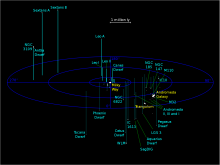Listen to today's episode of StarDate on the web the same day it airs in high-quality streaming audio without any extra ads or announcements. Choose a $8 one-month pass, or listen every day for a year for just $30.
You are here
Spring Milky Way
The glowing band of the Milky Way is always tough to find. It’s so faint that you need to get far away from city lights to see it. But this time of year is especially challenging, because the Milky Way doesn’t soar high across the evening sky as it does in summer and winter. Instead, it brackets the sky — it’s low in the west after nightfall, and in the east before dawn.
It’s all a matter of perspective. During summer, Earth faces the center of the Milky Way Galaxy around midnight, so the galaxy’s crowded inner regions climb high overhead. And during winter, we face opposite the galactic center, so the galaxy’s faint outer precincts top the sky.
About now, though, we’re looking at a right angle to the galaxy’s disk around midnight — away from our galactic home and toward intergalactic space. You can see the Milky Way, but not at its best.
In early evening, it arcs across the west. Its path is traced by Sirius, the brightest star in the night sky, which is in the south-southwest; bright orange Betelgeuse, well to the upper right; and W-shaped Cassiopeia, low in the northwest.
And as Earth turns during the night, a different region of the Milky Way rotates into view before dawn. It arcs high across the east, from Cassiopeia — now in the northeast — to the Northern Cross and over to teapot-shaped Sagittarius in the south — a section of the Milky Way that will highlight the evening skies of summer.
Script by Damond Benningfield






